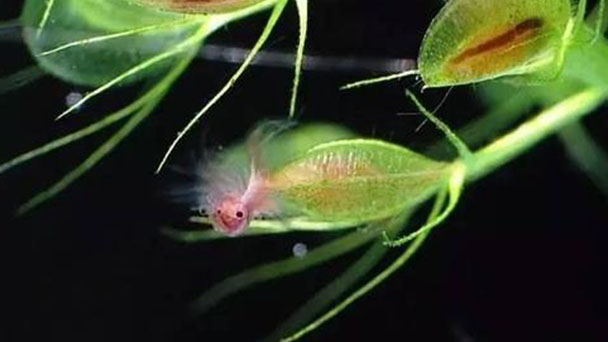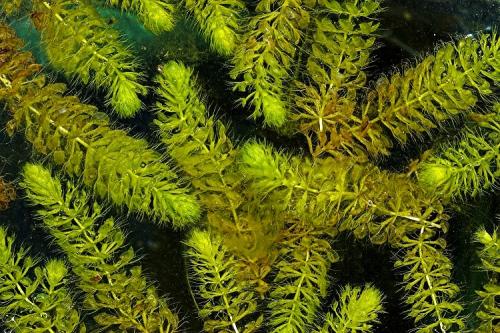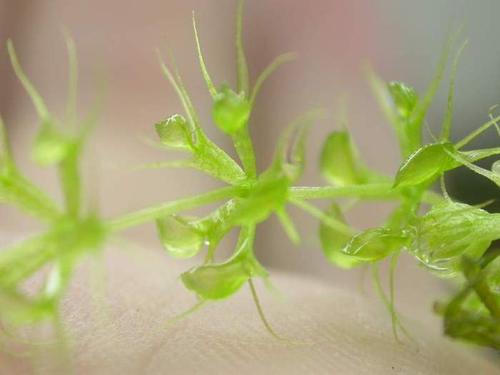Waterwheel plant (Aldrovanda vesiculosa) profile
Written by Maggie
Mar 19 2021

Waterwheel plant (Aldrovanda vesiculosa) is the only living species of raccoon genus in the family Anacardiaceae. Waterwheel plants prey on small aquatic invertebrates with traps similar to the Venus flytrap. The trap wheel is attached to the stem. A Waterwheel plant is one of the few plants with the ability to move quickly. Waterwheel plants are distributed in four continents. Different regions have certain differences in the morphology of Waterwheel plants.
Waterwheel plants produce winter buds to withstand the cold winter months. Before the onset of winter, the growing point will grow a large number of short and compact non-insectivorous leaves, so as to wrap around the growing point. After that, the winter buds fall off the mother. Because of its dense texture, it sinks to the bottom. If the bottom temperature is stable and relatively warm, the growing points can survive the cold winter safely. The underwater winter bud can tolerate temperatures as low as -15℃.
Waterwheel plant picture

Morphological characteristics of waterwheel plant
Waterwheel plant is a floating-water herb, 6~10 cm long. The top is growing, and the ends are aging and necrotic. It grows rapidly, producing one or more whorls per day. waterwheel plants in Japan can grow 4~9mm per day.
Leaf blade
Waterwheel plant is impeller, 6~9 pieces per round, base joint; Petiole is 3~4 mm long, top with 4~6 diamond-shaped slit, slit length 5~7 mm; Leaf blade is reniform when spreading, 4 -- 6 mm long, 6 -- 10 mm wide. the waterwheel plant trap consists of two blades similar to the flytrap pansy, but smaller and located underwater.
Leaves of waterwheel plant are with glandular hair and inductive hair, when stimulated by the two parts to the middle rib as the axis of mutual close, the outer ring close, the central formation of a bursa, in order to capture insects. Under appropriate conditions (the water temperature is about 20℃), the whole process of closing the Waterwheel plant trap takes 10-20 milliseconds, which is the fastest plant in the plant world. Each trap is surrounded by four to six long hairs 6 to 8mm long to prevent impurities in the water from irritating the trap to close.
Inflorescence
When a Waterwheel plant blossoms, the flower is supported on the surface of the water by a short stalk. Waterwheel plants have small flowers. Flowers are simple leaf axils, short petiolate; Waterwheel plant has 5 sepals, basally connate, ovate-elliptic or elliptically oblong, 3 -- 4 mm long, petals 5, white or pale green, oblong, 3 -- 4 mm long, ca. 2.5 mm wide; Waterwheel plant has 5 stamens, filaments subulate, anthers lobed longitudinally; Ovary is subglobose, 2 -- 2.5 mm in diam., lateral membrane placenta 5, style 5, apically dilated multilobed. Each flower blooms for only a few hours, and after pollination, the entire structure sinks underwater and sets. Waterwheel plants rarely bloom.
The root system
Seedlings of Waterwheel plant that germinate from seeds have underdeveloped roots, but they quickly die and fall off.
The fruit
Fruit of the Waterwheel plant is subglobose, not dehiscent;Seeds from the pericarp decayed, 5 to 8 or fewer, black. When the seeds germinate, the cotyledons remain in the seed coat.
Winter buds
Waterwheel plants produce winter buds to withstand the cold winter months. Before the onset of winter, the growing point will grow a large number of short and compact non-insectivorous leaves, so as to wrap around the growing point. After that, the winter buds fall off the mother. Because of its dense texture, it sinks to the bottom. If the bottom temperature is stable and relatively warm, the growing points can survive the cold winter safely. The underwater winter bud can tolerate temperatures as low as -15℃.
In the wild, the success rate of winter buds sinking to the bottom is low. Those winter buds that do not sink to the bottom will eventually be eaten or frozen to death by waterfowl.
When spring comes and the water temperature reaches 12~15°C, winter buds begin to germinate and grow. During dry periods in summer, Waterwheel plants also produce non dormant winter buds - like tissues.
Ecological habits of waterwheel plant
Waterwheel plants live in shallow, clean, warm water. Its growth requires plenty of sunlight and low levels of nutrients in the water, with a pH of about 6. It is commonly found floating in rushes, reeds, and rice.
Cultivation conditions of waterwheel plant as ornamental aquatic grass
Illuminance: 2500 Lux
Water temperature: 5-30 ℃
Location: Middle and rear grasses
Hardness: 2-10 DH
Ph value: 5.0-6.5
Difficulty: Difficulty

The propagation method of waterwheel plant
Waterwheel plants are usually asexually bred.
Under favorable conditions, adult plants will sprout at intervals of 3 to 4cm.
The lateral buds continue to grow and divide into two plants as the junction becomes senile and necrotic. Because the growth speed of Waterwheel plant is fast, a large number of new plants can be produced in this way in a short time.
Variety classification of Waterwheel plant
Aldrovanda Vesiculosa var. aquitanica Durieu ex Diels (1906) Nom. Illeg.
Aldrovanda Vesiculosa var. Australis Darwin (1876)
Aldrovanda Vesiculosa var. Duriaei Caspary (1859)
Aldrovanda Vesiculosa Var. Verticillata (Roxb.) Darwin (1876)
The distribution area of waterwheel plant
Waterwheel plants are widely distributed in Europe, Asia, Africa and Australia, but they are extremely rare. In China it is produced in Heilongjiang.
Waterwheel plants are spread through the migration of birds -- they attach themselves to the feet of birds and are taken to another area as they migrate. So most Waterwheel plants are located along bird migration routes.

Latest Updated
- Benefits of Bugleweed - 7 Science-backed Health Benefits
- Bugleweed Dangers & Side Effects - Is It Poisonous?
- How to Plant Evergreen Trees - What You Should Know
- When to Plant Evergreens - Grow Guide for Evergreen Trees
- 12 Wonderful Evergreen Shrubs for Your Garden
- 12 Popular Evergreen Plants with Pictures for Beginners
- When And How To Prune A Lilac Bush Like a Pro
- How to Grow & Care for Lilac Vine (Hardenbergia Violacea)
- Japanese Lilac Tree (Syringa Reticulata) Care & Propagation Guide
- Shumard Oak Pros and Cons - What to Know
Popular Articles
- Winter maintenance of Antirrhinum Majus
- How to Grow Terminalia Mantaly Tree
- How to Grow and Care for Crossostephium Chinense
- How to grow Antirrhinum Majus in spring
- Peristeria Elata (Dove Orchid) Profile: Info & Care Guide
- Underwatered Snake Plant (Sansevieria Trifasciata) - Signs And How To Fix
- How to Care for Brazilian Jasmine Plant (Mandevilla Sanderi)
- How to Grow & Care for Graptopetalum Purple Delight in Summer
- Rosa Chinensis (China Rose): Plant Growing & Care Tips
- How to Care for Baby Sun Rose (Aptenia Cordifolia)